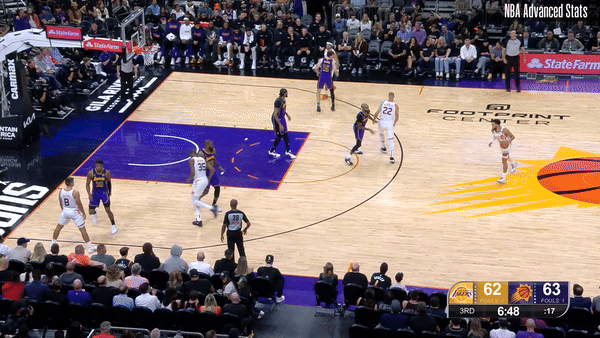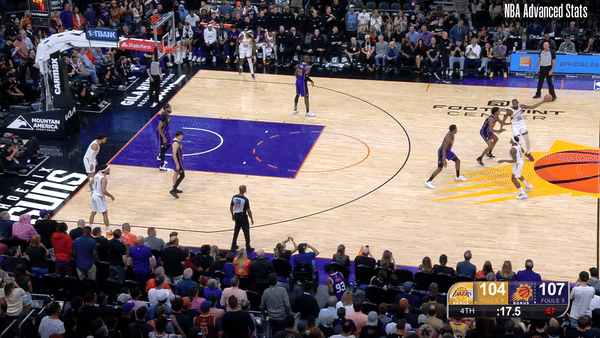A week into the NBA season, we are still in small sample size territory. Any overarching claims about what teams, players, and coaches are doing need to be heavily caveated. Certain things are starting to take shape though; Nekias Duncan and Steve Jones Jr. cover some of these emerging trends on the most recent episode of their essential Dunker Spot podcast (e.g. the Milwaukee Bucks committing to icing every pick-and-roll.)
One trend that pundits much smarter than yours truly predicted is that the Phoenix Suns would have a better offense under new coach Mike Budenholzer. I am more interested in seeing how Coach Bud, whose teams have historically been defensively stout, would cobble together a serviceable team defense. After having All Defense caliber talent in previous stints with the Bucks and the Atlanta Hawks, he has fewer tools in Phoenix. Through four games, the Suns are giving up just 109 points per 100 possessions, seventh best in the league. If the trend continues, I’ll be digging into what the Suns are doing.
Today though, I want to focus on the Suns’ offense. Most people expected the Suns under Coach Bud to jack up more threes and they are certainly doing that; per Cleaning the Glass, the Suns are attempting nearly 20% more of their shots from three-point range compared to last season. Alarmingly, that shift has come about entirely through a decrease in rim attempts, where Phoenix ranks dead last in the league. Phoenix was a bottom-five team in that metric last season, so they may never be a rim pressure team with their current personnel. That having been said, by trading rim attempts for threes, they may be solving one math problem by creating an even bigger one.1 That shot profile is worth monitoring.
A fun set from Phoenix’s win over the Los Angeles Lakers last night was this one, using decoy screening action between Mason Plumlee and Devin Booker to occupy Anthony Davis before Kevin Durant ran off a Plumlee screen for an open three:
As impressive as LeBron James has looked in Season 21 (more on that in a bit), it is a lot to ask him to chase players around screens. With the Lakers willing to switch 1 through 4, but keep Davis in the paint as much as possible, this was a smart way to free KD up.
On the Lakers switching: I don’t have Second Spectrum access, but the eye test suggests that their defense is switching much more under new coach JJ Redick than they did last season under Darvin Ham. They have been willing to give up even easy switches, rarely resorting to strategies such as hedge-and-recoveries. The Suns exploited this down the stretch, leading to two crucial KD baskets that sealed the game for Phoenix in the clutch. Sometimes when a team is switching, the simplest counter is to get the mismatch switch and cook.
With the other three Suns players plastered to the baseline, taking their defenders with them, Bradley Beal goes up to screen for KD. The Lakers switch Beal’s defender, the smaller Gabe Vincent, onto KD while the bigger Rui Hachimura switches onto Beal’s roll. With no help defender around, KD Is able to get to his spot and easily shoot over Vincent:
Note KD driving right there, away from Anthony Davis and towards the side of the court with just a single defender (Bron.) With Royce O’Neale only one pass away in the near side corner, Bron cannot stunt towards KD and risk an open three.
The next play down, the Suns run the identical play, again getting Vincent switched onto KD. Although the strong side help defender, in this case Austin Reaves, does stunt at KD somewhat, he is too occupied by Devin Booker to seriously bother KD:
Perhaps the Lakers should have tried something else earlier. On one of the last possessions of the game, the Lakers finally tried doubling KD on the ball screen, forcing the ball out of his hands and trusting their defense to rotate behind the ball. In this case they successfully did (the Lakers defense on this play is on a string, fun to watch), forcing a rushed O’Neale three.
Unfortunately it proved too little too late and the Suns escaped with a win.
A Word Picture on Bron
Lebron James is getting justifiable plaudits for how good he looks in this, season 21. There is no precedent. The last of LeBron’s eight assists last night brought me so much joy:
We have gotten so used to Bron that this play went most unremarked. But that’s a full-court, underhand flick hitting D’Angelo Russell perfectly in stride for the layup. Greatness never gets old.
A Word on Grammar
In the Lakers-Timberwolves season opener, Stan Van Gundy chided Ian Eagle on commentary for saying that the Timberwolves had “cut the lead to single digits”. Van Gundy’s argument was that the correct usage would be to say that the Timberwolves had cut the lead to single digit, since anything less than 10 is a single digit and not a single digits.
After some consideration and with due respect to Van Gundy, From The Logo contends that he is wrong.
In saying that the Timberwolves had cut the lead to single digits, Eagle was noting that the lead was now under 10 i.e. within a range of numbers comprised of single digits. While each of the numbers in that range constitute a single digit, Eagle’s reference was to the range of possible values that the lead could take. For instance, when we say that a trailing team would like to reduce a deficit to single digits before the half, we mean to say that they would like the deficit to be under 10 (with the understanding that a deficit under 10 feels more manageable than a double digit deficit.) So we don’t mean that they would like the deficit to be a specific number under 10, but rather, a range of surmountable values under 10. Hence single digits, not single digit.
If you have made it this far, I apologize.
In theory, greater pressure from beyond the arc could space out teams and eventually open up lanes for Phoenix to find more efficient rim attempts. In the early going, Phoenix is tearing it up when they do get to the rim, but that’s only worth so much when you barely attempt any shots in the league’s most valuable real estate.







